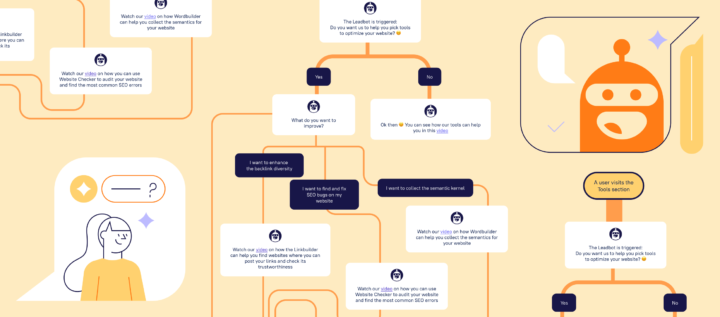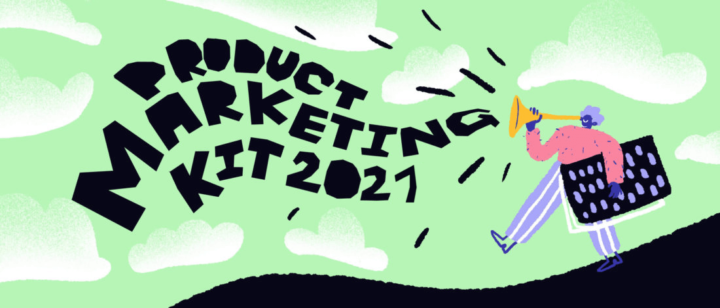Everything You Wanted to Know About Product Marketers

Product marketing manager, PMM, or a product marketer is a trendy IT role, though it’s not widely known yet. Dimitrii, Dashly CEO & Founder, has invited Helene, Product Marketing Manager at Dashly, Lana, Head of Marketing Products at Skyeng, and Helene, Product Marketing Manager at Miro, and interviewed them about product marketers. The guys discussed what product marketers do, how you can get a job, what you should know to be a product marketer, and what can get you discharged from this position.
Who is a product marketer?
Helene from Miro: A product marketer works together with a product manager while planning feature releases. Together they decide on the target audience and then begin research and hypotheses validation. Their roles divide when it’s time to set feature targets and objectives. A PM (product manager) strives for product development and stating hypotheses to be validated during user interviews. As a PMM (product marketing manager), I’m responsible for the feature launch.
In a nutshell, a PM answers the question “What does this feature mean?”, and a PMM knows how you should market it. But, of course, they are both responsible for the future success.
Another job of a PMM is to formulate the go-to-market strategy. This means you know who you’re releasing for, why you do it, and how you’re going to win the market you select.
Helene from Dashly: That’s the same product manager. The only difference is that a PM usually teams up with developers, while a PMM mostly interacts with marketing and other teams. A PMM joins PMs when planning a feature. They do competitor analysis from the positioning viewpoint rather than the functionality; they talk to users to understand their needs and possible fears.
As a PMM, I also need to clue in marketing, sales, and support teams on what’s happening with the product and what we’re currently working on.
Lana from Skyeng: Actually, we don’t have non-product marketers. At Skyeng, all marketers should be product ones by default.
At Skyeng, we’re providing analytical support to our marketing fellows. We give them the numbers and conclusions and tell them where they should be heading while a feature is in the works. Plus, we’re responsible for the C0 conversion rate (traffic -> application form) in all channels.
I’m working together with growth teams. You know, like a mobile acquisition team where we combine marketing with the main product in mobile channels.
We don’t have non-product marketers
Why are a product marketer and a “regular” marketer different?
Helene from Miro: Don’t look for differences, okay? A product marketer must have a marketing background to understand your target audience, distribution channels, etc.
I’m a marketer, but I’m also closely connected to product and development teams. My marketing teammates are responsible for particular distribution channels. They take our aligned message and get it ready for distribution. And I’m a person in charge of formulating these messages and getting other teams to embrace it. I don’t think I’m any different from a “regular” marketer, I’m just specializing in underlying things.
Helene from Dashly: Well, I know our product better. Our marketing team mostly works at upper stages of the funnel. They create our brand and articulate which problems it is solving. I’m joining them when our user moves along the funnel and becomes familiar with our product. My other job is to help the marketing team present the product correctly, its strengths and ways to solve customer problems.
Marketing is all about interaction. I’m mostly telling my fellows about the stuff in our product.
Lana from Skyeng: These are just different roles. We’re not asking why a frontend developer and a developer are different, are we?
How can I become a product marketer?
Helene from Miro: When I joined Miro, I already had experience in IT. First, I tried to cover the existing gaps. Oh, God knows how many different things I was doing.
A year later, the company realized the need for a product marketing team. I had relevant experience, so I took the responsibility for the product segment in it.
When we formed a team, we had no idea how to get along with the product team. They were showing new features to marketers, and they started to communicate more, but marketers still didn’t get what was going on.
We’re keeping the balance now: product marketing is right between product and marketing. We’re using this approach to interact with customer-facing teams. It’s us who tell them about new releases.
People often come to product marketing without relevant experience. I came there as a result of an evolutionary process when we matched particular company needs to what I’m best at
Helene from Dashly: It’s my fourth year at Dashly. I originally joined the content marketing team and I was one of the first ten people in the company. Then, I switched to support, but my project didn’t match the support team KPIs. After that, I joined the product team. I was copywriting use cases, knowledge base articles, and other useful content.
Once upon a time, Dimitrii approached me and asked if I was aware I was in product marketing. Since then, I’ve been trying to figure it out for over a year now. Quite successfully, I guess 🙂
Read also:
👉 Live Chat Best Practices: 20 Hacks to Make Customer Service Better
👉7 Best Live Chat for eCommerce: Boost Conversion on your Website
👉 Top 5 live chat mobile app: find the best fit for your business
👉 Live Chat: How Online Chat Tool Can Help Your Business
👉 20 Best Live Chat Software for your website chat service
👉 Acquisition funnel marketing: Grow customer conversions at each step of user journey
👉 The top 15 inbound marketing tools: harness digital power and elevate your business
👉 10 best website personalization tools to deliver top-notch visitors experience
👉 7 best email capture tools: features and pricing compared for 2024
Lana from Skyeng: I’m about the product, not marketing. I was in marketing for 10-12 years and then came to Skyeng as a product manager in the marketing department. As time passed, there were a lot of us, and we had several separate marketing teams. Turned out, my team had a lot of product managers, and I became a department head.
What does a product marketer do?
Helene from Miro: When a new quarter comes, we gather with a PM and developers to discuss our plans and OKRs. After that, it’s time for user research, where our UX designer, a product manager, and I are engaged. We interview our users to see what pains they have and which of them we’re going to cure with our new feature.
Next, we’re developing the go-to-market strategy for a potential feature together with a PM and an analyst, and I help them evaluate our expectations. Then, we’re attending the product review together and share our vision.
At the go-to-market meeting, we’re elaborating on the feature value and the purpose of the launch for team leads. We also share our ideas on the feature release and our approach to evaluating results. The development process begins only after that, and I help a PM and an analyst choose a sample for a beta test and work out the onboarding process.
Before the release, we gather with the marketing team to discuss landing pages and videos to support the feature. When it’s released, we hold training sessions for Success, Support, and Sales teams to get everyone aware. After a month, we reflect back on the launch.
Helene from Dashly: When my journey began, I was creating content about the product, while our marketing team was writing more “general” articles. Then it dawned on us that it’s hard for marketers to develop landing pages because they don’t know users so much as the product team does. That’s why I took on landing pages.
At the same time, I’m telling my fellows from marketing and sales about our plans and how we’re doing. This helps them concentrate on the feature development.
A product marketer is a liaison between product and marketing teams. They translate what product managers say so that people understand it
Lana from Skyeng: We don’t have a particular role of a product marketer, but we use product skills to evaluate candidates. We check that as many people have product marketing expertise; we want them to know what a feature, shipping, customer delivery, and other notions are. If a person can somehow navigate these terms, we’re ready to make a better offer.
Product marketers are responsible for everything happening with a feature: they do research, set objectives, and decide on the target audience.
Regarding the ordinary product marketer, we don’t need one as we’re an operational IT company. Our features are simple. Users don’t have time for proper onboarding and they expect us to help them.
If we think a feature has potential and it may boost our metrics, we’re putting all our operational effort into it. First, we have to prove it to our operation fellows, not our customers. After that, operation managers will do their best to communicate the value of this feature. Skyeng is a marketing-driven company, and most employees are engaged in cross-functional activities.
What does a product marketer need to know?
Helene from Miro: It depends on what a business needs, but there are general concepts:
- Learn to empathize and communicate what users understand and find appealing.
You can’t be a product marketer if you don’t know the true pains of your users. You need to feel them deeply.
- Understand the business and know business metrics.
If a product marketer can’t embrace it, they will evaluate the feature success the wrong way.
- Develop soft skills.
A product marketer communicates with everyone in the company. The easier your thoughts are to understand, the more successful you are.
- Be agile and creative.
Doing things the ordinary way is an overwhelming temptation. Develop critical thinking. “Are we going to do this the regular way or try something new to boost the metric?” Know WHY you’re doing something before you hand the task to operations.
Helene from Dashly: I’ll only add a couple of things as Helene mentioned all major points:
- Know how to tell a product or a feature story.
- Know how to pack your product and demonstrate how a product solves user problems. Emphasize that a user needs exactly this feature, and other people need different features.
You need to be able to explain why you did all this in the platform
Lana from Skyeng: Many things depend on the company culture. Product marketers at Skyeng have a strong entrepreneurial mindset. We calculate the team’s ROI, all teams have their budgets. We’re all entrepreneurs on the inside.
All in all, you need to pursue your agenda if necessary. This is an important story of a large company.
Read also: Automated Sales Funnel Software The 15 Best Options
How do you develop a feature?
Helene from Miro: We want to cure user pains and make them happy with our product. You need to have a product strategy. This is your view of the world in 5 years. There are features our users didn’t want, but we believed in them. And we got great business outcomes.
Two or three weeks prior to the development, you need to make the first iteration of problem interviews. First, conduct in-depth interviews, select hypotheses for broad validation, and then send bulk questionnaires. When an MVP appears, we’re having another round of research, and then we employ beta testing, research, and interviews to test the working version.
Sometimes it’s easier to develop a feature and a/b test it. Once we had a positive experience with a feature when we had a user who didn’t understand the Miro interface. Instead of asking what features they missed and what templates they used we simply created new ones. This helped us boost the conversion rate.
Helene from Dashly: As for our latest feature, we spent a week on user research before we set a task to develop a feature. During research, I always create a kickoff document to describe a feature. This will help everyone understand why we need a feature, how it works, and why it is helpful to our users.
When we have an MVP, we’re running hallway tests. If I don’t have time for some research, I’m doing it while a feature is being developed; we can have it both ways.
Got It! Check Your Email

It takes from two sprints (one sprint lasts for two weeks) to develop a large feature, sometimes even more.
We also have the growth team, and they manage to validate five hypotheses per week. Then they share the hypothesis that worked, and suggest to develop it. This is very helpful.
Lana from Skyeng: We’re approaching features in different ways. I have a feature that’s stuck for over a year. Sometimes there are technical issues, no traffic for a proper A/B test, or conceptual problems. And there are features we’re not even researching. In case of a simple thing like “Signing up for an introductory class” it’s easier for us to implement the feature or run a quick hallway test.
When a feature is a success, we spend less time on the analysis of it. Instead, we’re trying to see why other hypotheses didn’t kick in. Then we take a feature and approach the same or new users and conduct in-depth interviews.
How is the product marketer’s personal success measured?
Helene from Miro: My metrics are related to launches. During them, I get to see which messages are better or worse. Plus, I understand clearly what part of the feature development I’m responsible for.
Speaking of super personal OKRs, I’m responsible for everything about optimization, like formats or messages. I set them and iterate on them myself.
Helene from Dashly: My personal OKRs are about processes. It’s important to make sure all operations are teamed up with marketing and product teams. We all need to see where we can improve.
Lana from Skyeng: There are experiments and projects where the ROI is a major metric. But there are also infrastructure projects with infrastructure metrics you simply MUST meet. For example, if the marketing team acquires 5% more customers than planned, we won’t be able to find tutors for these students, and we’ll lose customers.
I also have two high-level metrics: N (new user count) and Customer acquisition cost which is a limiting metric.
What makes the product marketer’s daily working routine?
Helene from Miro: I use all hours in a day. We’re distributed across the globe, and it’s convenient to schedule meetings using different time zones.
We have a lot of mandatory meetings, but I’m doing my best to concentrate on work. It’s important for me to have the time to think over the go-to-market strategy.
There are more product teams than product marketers. If you start helping everyone, you won’t have time for your tasks. Be sure to dedicate some time to your personal tasks at least once a week
Helene from Dashly: My typical working day is something like this:
- writing blog articles about product features;
- attending many meetings;
- writing articles for our knowledge base and for the “What’s new?” section on our website;
- developing product landing pages (prototyping, discussions with designers, hallway tests);
- communicating with beta testers of a new feature, collecting feedback, and writing (hopefully) success stories.
- doing basic operations to get everyone connected and avoid questions like “When are we releasing it? Are we there yet?”
Conversations take so much time that I feel I didn’t do anything useful. But they actually work out and everyone understands what’s going on in the product.
Lana from Skyeng: It all depends on the company. There are companies where people are ready to leave at 5:59 PM. And there’s Skyeng where no one knows what the “after work” means.
Usually we have irregular working hours. It doesn’t matter where you are and when you start working. What’s more important is that you meet objectives you and the company set for you.
The working schedule is total bullsh… in Skyeng, but it’s up to you to work it out. That’s why we’re growing at the speed of light.
What can get a product marketer discharged?
Helene from Miro: At Miro, the process is in several levels:
- When a person joins us with any role, they are given a personal assignment. If they can’t manage to accomplish it, we’re breaking up with them.
- Management. We’re not saying “Do this by that time”. We say “This is our objective, and you should contribute to achieving it”. If a person can’t do this, we part our ways.
- C-level. A person is assigned a domain where they should show their worth. If they can’t meet the targets, they leave the company.
Helene from Dashly: We have two major deal-breakers that may get anyone from any team discharged:
- If a person is toxic.
- If a person can’t accomplish tasks and meet expectations.
At Dashly, we’re doing our best to clearly articulate our expectations of a person. When a new person joins or an employee takes on another role, they are provided with a 3-month onboarding plan. The plan and the anticipated results are aligned with the management. When three months pass, they reflect back together on how well a person performed, and a manager makes their final decision.
Lana from Skyeng: Well, my response is simple. A person sets monthly or quarterly plans; it’s their commitment. If they can’t comply with it, they’ll get laid off. This is probably the only reason. And we always comply with our commitments, we just can’t do the other way?
As a head, I have the minimum plan (what I MUST do), the average plan (when everything is great and I’m doing great), and the highest plan (when I’m a superwoman). If I can’t meet even the average target, I’m getting laid off.
The product marketing manager is a complicated but an exciting role, and companies only begin to understand the importance of it now.










